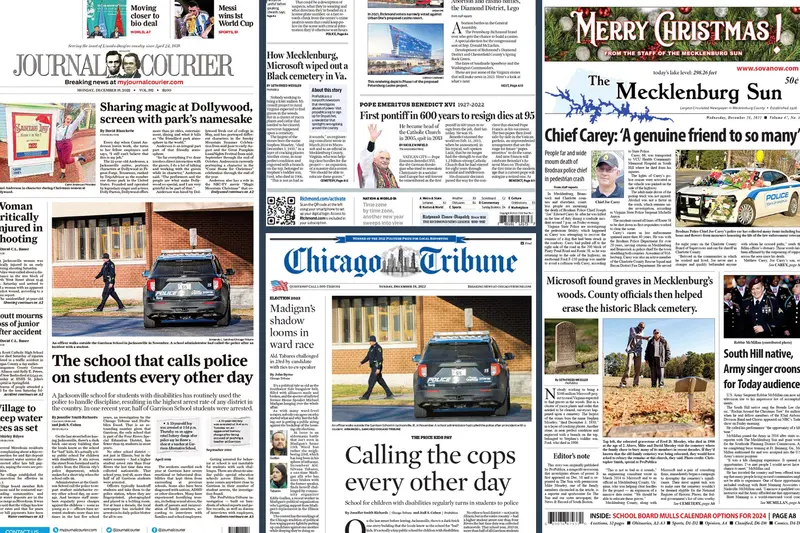The 4-Minute Rule for News Articles
The 4-Minute Rule for News Articles
Blog Article
News Articles - Questions
Table of ContentsThe Definitive Guide for News ArticlesNews Articles - The FactsWhat Does News Articles Mean?About News ArticlesThe Main Principles Of News Articles
Excellent knowledge of various topics provides trainees an one-upmanship over their peers. Despite the fact that digital and social networks are easily easily accessible, we need to not fail to remember exactly how crucial it is to check out the newspapers. Moms and dads need to attempt and instill the habit of reviewing a paper as an everyday regimen to proceed the heritage of the revered print medium.Information tales additionally contain at the very least one of the following important characteristics relative to the desired audience: distance, importance, timeliness, human passion, anomaly, or effect.
Within these limits, news tales also aim to be detailed. Among the bigger and extra revered papers, fairness and equilibrium is a major variable in providing information.
Newspapers with a global audience, as an example, tend to use a much more official style of composing. The details selections made by an information electrical outlet's editor or editorial board are typically gathered in a design overview; usual style overviews consist of the and the US News Design Book. The main objectives of news writing can be summed up by the ABCs of journalism: accuracy, brevity, and clearness.
The Facts About News Articles Revealed
As a guideline, reporters will not use a long word when a brief one will do. Information authors try to stay clear of making use of the very same word more than once in a paragraph (in some cases called an "echo" or "word mirror").
Headlines occasionally omit the topic (e.g., "Jumps From Watercraft, Catches in Wheel") or verb (e.g., "Cat woman fortunate"). A subhead (additionally subhed, sub-headline, subheading, caption, deck or dek) can be either a subordinate title under the major headline, or the heading of a subsection of the write-up. It is a heading that comes before the main message, or a group of paragraphs of the major text.

Additional signboards of any of these kinds may appear later on in the short article (especially on subsequent web pages) to entice more analysis. Such billboards are additionally utilized as reminders to the short article in various other sections of the publication or site, or as promotions for the piece in various other publication or sites. Typical framework with title, lead paragraph (recap in vibrant), other paragraphs (details) and get in touch with info.
Instance of a hard-lead paragraph NASA is recommending another space job. The firm's budget request, announced today, consisted of a plan to send another mission to the Moon. This time the firm really hopes to develop a long-term center as a jumping-off point for other room experiences. The budget demands approximately $10 billion for the project.
The NASA statement came as the agency requested $10 billion of appropriations for the job. An "off-lead" is the page 2nd crucial front page information of the day. The off-lead appears either in the top left edge, or directly listed below the lead on the. To "bury the lead" is to begin the post with background information or information of second value to the visitors, requiring them to learn more deeply into an article than they need to need to in order to uncover the crucial points.
Not known Details About News Articles
Typical use is that a person or more sentences each develop their own paragraph. Reporters generally describe the organization or structure of a newspaper article as an inverted pyramid. The important and most intriguing components of a story are placed at the start, Get the facts with sustaining info following in order of decreasing value.
It enables people to explore a topic to just the depth that their curiosity takes them, and without the charge of information or subtleties that they could take into consideration unimportant, yet still making that details offered to much more interested readers. The upside down pyramid structure additionally allows posts to be cut to any approximate length during design, to fit in the area offered.
Some writers begin their stories with the "1-2-3 lead", yet there are several kinds of lead offered. A twist can refer to numerous points: The last tale in the news broadcast; a "satisfied" story to finish the show.
Longer posts, such as magazine cover write-ups and the items that lead the inside sections of a paper, are called. Feature tales differ from straight information in numerous ways. Foremost is the absence of a straight-news lead, a lot of the time. As opposed to providing the significance of a tale up front, feature writers might try to tempt readers in.
Some Ideas on News Articles You Should Know
An attribute's first paragraphs often relate a fascinating minute or event, as in an "unscientific lead". From the particulars of a person or episode, its view quickly widens to generalizations regarding the story's topic.

The Editor's Tool kit: A Reference Guide for Beginners and Professionals (2001) Allan M. Siegal and William G. Connolly. The New York Times Guidebook of Design and Use: The Authorities Design Guide Made Use Of by the Writers and Editors of the Globe's Most Authoritative Newspaper (2002) M. L. Stein, Susan Paterno, and R.
Report this page